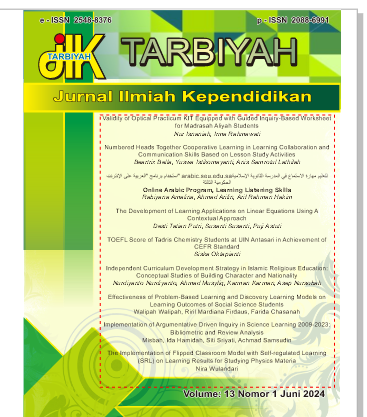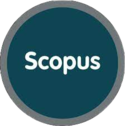The Implementation of Flipped Classroom Model with Self-regulated Learning (SRL) on Learning Results for Studying Physics Material
DOI:
https://doi.org/10.18592/tarbiyah.v13i1.12368Keywords:
flipped classroom , learning outcome , physics material , self regulated learningAbstract
The Flipped Classroom is a variation of the learning model that can be given to students. This experiment describes the impact of providing a Flipped Classroom model with a Self Regulated Learning (SRL) strategy on students' learning outcomes. This research uses a quasi-experiment type with a one-group pre-test and post-test design. The sample was selected using a random sampling technique. This experiment details that applying the Flipped Classroom model with the SRL strategy has an impact on improving learning outcomes. The research results found that the average score for studying Physics Material on the pre-test was 53.00, while it increased to 76.50 on the post-test. This comparison is descriptively shown by a significant increase in understanding of the material after implementing this learning model. This study uses a paired sample t-test, and it was found that there was a significant increase in learning outcomes in the Study of Physics Material. These findings confirm that applying the Flipped Classroom model with the SRL strategy quantitatively improves learning outcomes in the Study of Physics Material and creates interactive learning. Active involvement of students in the learning process has an impact on increasing cognitive abilities, according to Bloom's Taxonomy (revised edition). Studying Physics material using the Flipped Classroom with the SRL strategy can improve learning outcomes and create more effective and interactive learning experiences.References
Arsyad, R. N., Pomalato, S. W. D., Abbas, N., & Achmad, N. (2022). Hubungan Antara Self Regulated Learning dengan Hasil Belajar Matematika Pada Materi Trigonometri. Jambura Journal of Mathematics Education, 3(1), 48–56. https://doi.org/10.34312/jmathedu.v3i1.12423
Ayu, A., & Meutia, E. (2020). Meningkatkan Self Regulated Learning pada Mahasiswa Melalui Creative Art : Teori dan Aplikasi. JIHAFAS Vol. 3, No. 2, Desember 2020, 3(2), 120–131.
Baig, M. I., & Yadegaridehkordi, E. (2023). Flipped classroom in higher education: a systematic literature review and research challenges. International Journal of Educational Technology in Higher Education, 20(1). https://doi.org/10.1186/s41239-023-00430-5
Brenner, C. A. (2022). Self-regulated learning, self-determination theory and teacher candidates’ development of competency-based teaching practices. Smart Learning Environments, 9(1). https://doi.org/10.1186/s40561-021-00184-5
Colomo-magaña, E., Soto-varela, R., Ruiz-palmero, J., & Melchor, G. (2020). education sciences University Students ’ Perception of the Usefulness of the Flipped Classroom Methodology. 1–20.
Darmawati, N. W. S. (2022). Model Pembelajaran Inovatif Bahasa Indonesia Berbasis Flipped Classroom pada Era Digital dengan Pemanfaatan Google Classroom. Jurnal Pendidikan Dan Pembelajaran Bahasa Indonesia, 11(2), 168–177.
Fridayani, J. A., Kusuma, S. E., & Yuniarto, A. Y. (2022). Building Link-Match of Gen Z and The World Of Work Through Contextual-Adaptive Facilitation. Jurnal Bisnis Strategi, 31(2), 46–58. https://ejournal.undip.ac.id/index.php/jbs/article/view/48082
Hoshang, S., Hilal, T. A., Hilal, H. A., Hilal, T. A., & Hilal, H. A. (2021). ScienceDirect ScienceDirect ScienceDirect Investigating the Acceptance of Flipped Classroom and Suggested Recommendations Investigating the Acceptance of Flipped Classroom and Suggested Recommendations. Procedia Computer Science, 184, 411–418. https://doi.org/10.1016/j.procs.2021.03.052
Jaya, P. A. E. S. (2023). Penerapan Model Pembelajaran Flipped Classroom dengan Integrasi Diferensiasi Produk untuk Meningkatkan Aktivitas dan Hasil Belajar Ekonomi Siswa Kelas XII IPS 1 SMA Negeri 2 Busungbiu. Ekuitas: Jurnal Pendidikan Ekonomi, 11(1), 131–142. https://doi.org/10.23887/ekuitas.v11i1.63595
Jdaitawi, M. (2019). The Effect of Flipped Classroom Strategy on Students Learning Outcomes. 12(3), 665–680.
John W. Creswell, J. D. C. (2017). Research Design: Qualitative, Quantitative, and Mixed Methods Approaches. SAGE Publications. https://www.google.co.id/books/edition/Research_Design/335ZDwAAQBAJ?hl=en&gbpv=1
Låg, T. (2019). Does the Flipped Classroom Improve Student Learning and Satisfaction ? A Systematic Review and Meta-Analysis. 5(3), 1–17. https://doi.org/10.1177/2332858419870489
Latip, A., Robandi, B., Amaliah, A., Khakim, R. R., & Fatonah, N. (2023). Technological Pedagogical Content Knowledge (TPACK) Framework for Science Teachers’ Comptences in Facing Global Challenges and Issues: A Narrative Literature Review. International Journal of Pedagogy and Teacher Education, 7(1), 45. https://doi.org/10.20961/ijpte.v0i0.74699
Luo, R., & Wang, Y. (2023). Enjoyment, boredom, and perceived effectiveness of learners in language MOOCs: the mediating effect of self-regulated learning. Frontiers in Psychology, 14(June), 1–13. https://doi.org/10.3389/fpsyg.2023.1145773
Mahmudi, I., Athoillah, M. Z., Wicaksono, E. B., & Kusumua, A. R. (2022). Taksonomi Hasil Belajar Menurut Benyamin S. Bloom. Jurnal Multidisiplin Madani, 2(9), 3507–3514.
Meliani, F., Sobron Muhyiddin, D., Ruswandi, U., Arifin, B. S., Suzana, S., Bunga, I., Cirebon, B., Sunan, U., & Djati Bandung, G. (2022). Challenges Of Using Technology In Islamic Religious Education Learning (Application of Flipped-Classroom in Class X PAI Subjects at SMA Plus Pagelaran Subang). Edukasi Islami: Jurnal Pendidikan Islam, 11(1), 41–51.
Nafiati, D. A. (2021). Revisi taksonomi Bloom: Kognitif, afektif, dan psikomotorik. Humanika, 21(2), 151–172. https://doi.org/10.21831/hum.v21i2.29252
Nurwahidah, I., Widiyawati, Y., & Sari, D. S. (2019). Pengembangan Iintegrated Science Assesment Berbasis PISA untuk Peserta Didik Kelas VII SMP. 7(2), 147–156.
Oishi, I. R. V. (2020). Pentingnya Belajar Mandiri Bagi Peserta Didik Di Perguruan Tinggi. IKRA-ITH Humaniora, 4(2), 50–55.
Purwanti, S. (2020). Analisis kemampuan mahasiswa dalam menyelesaikan soal IPA tipe HOTS. 4, 93–101.
Puspitarini, D. (2022). Blended Learning sebagai Model Pembelajaran Abad 21. Ideguru: Jurnal Karya Ilmiah Guru, 7(1), 1–6. https://doi.org/10.51169/ideguru.v7i1.307
Putra, D. S., Irawan, A., Yanto, J. P., Putra, M. M., Adli, S., Dewi, U. P., Nasih, N. R., Education, P., Program, S., Jambi, U., Education, M., Program, S., Jambi, U., Education, C., Program, S., Jambi, U., Education, H., Program, S., & Jambi, U. (2020). Relationship of Attitude With Student Learning. 9(2).
Shafrinia, N., & Fitriana, S. (2023). Analisis Self Regulated Learning Strategies Pada Siswa Kelas XI SMA Negeri 11 Semarang. 20(12).
Sonia, N. R. (2022). Model Flipped Classroom : Alternatif Pembelajaran Di Era New Normal Bagi Siswa Sekolah Dasar. Jurnal IBRIEZ, 7(1), 25–42.
Suardipa, I. P., Sedana, I. M., & Handayani, N. N. L. (2022). Pembelajaran Flipped Classroom Konten E learning. Edukasi: Jurnal Pendidikan Dasar, 3(1), 45. https://doi.org/10.55115/edukasi.v3i1.2298
Sunarto, M. J. D., Hariadi, B., Tan, A., Lemantara, J., Dinamika, U., Kedung, R., No, B., & Baruk, K. (2023). Pelatihan Model Pembelajaran Abad 21 dengan Flipped Learning untuk Guru SMA 21st Century Education Model Training with Flipped Learning for High School Teachers. Jurnal Pengabdian Kepada Masyarakat, 8(1), 18–25.
Supriyadi, S., Debora, & Ahmad Eko Suryanto. (2022). Self-Regulated Learning (Srl) First Year Students. BALANGA: Jurnal Pendidikan Teknologi Dan Kejuruan, 10(2), 55–60. https://doi.org/10.37304/balanga.v10i2.7781
Tarumasely, Y. (2020). Regulated Learning Dan Pengetahuan Awal. Jurnal Pendidikan Agama Kristen, 2(2), 98–110.
Tresnawati, C., Aryanti, F., & Suhaerah, L. (2022). Flipped Learning Dalam Meningkatkan Berikir Kritis Mahasiswa Pada Materi Fotosintesis Dimasa Pandemik Covid-19. BIOSFER : Jurnal Biologi Dan Pendidikan Biologi, 7(7 No 1). https://doi.org/10.23969/biosfer.v7i1.5752
Tsusayya, T. D., Umaroh, S. K., & Imawati, D. (2023). Motivasi Belajar dan Self Regulated Learning pada Mahasiswa dengan Sistem Pembelajaran Jarak Jauh. Jurnal Psikologi Terapan (JPT), 5(1), 1. https://doi.org/10.29103/jpt.v4i1.9368
Wulandari, M. (2020a). Konsep Dasar Metode Flipped Classroom. Https://Www.Usd.Ac.Id/Pusat/Ppip/2020/05/04/Konsep-Dasar-Metode-Flipped-Classroom/. https://www.usd.ac.id/pusat/ppip/2020/05/04/konsep-dasar-metode-flipped-classroom/
Wulandari, M. (2020b). Merancang Flipped Classroom. Https://Www.Usd.Ac.Id/Pusat/Ppip/2020/Page/2/. https://www.usd.ac.id/pusat/ppip/2020/05/04/merancang-flipped-classroom/
Zheng, L., Bhagat, K. K., Zhen, Y., & Zhang, X. (2020). The Effectiveness of the Flipped Classroom on Students ’ Learning Achievement and Learning Motivation : A Meta-Analysis The Effectiveness of the Flipped Classroom on Students ’ Learning Achievement and Learning Motivation : A Meta-Analysis. January.
Zimmerman, B. J. (2002). Becoming a self-regulated learner: An overview. Theory into Practice, 41(2), 64–70. https://doi.org/10.1207/s15430421tip4102_2
Downloads
Published
How to Cite
Issue
Section
License
Copyright (c) 2024 Nira Nurwulandari

This work is licensed under a Creative Commons Attribution 4.0 International License.
Authors retain copyright and grant the journal right of first publication with the work simultaneously licensed under a Creative Commons Attribution 4.0 International License that allows others to share the work with an acknowledgment of the work's authorship and initial publication in this journal.




